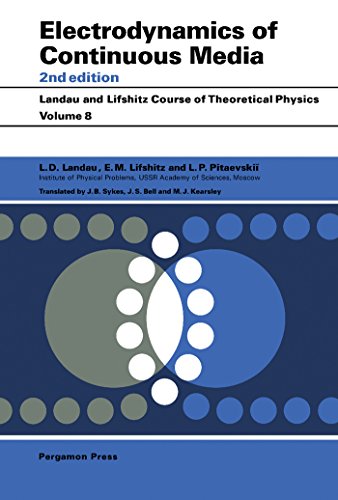Electrodynamics of Continuous Media (Book)
Electrodynamics of continuous media is the physics of electromagnetic (EM) fields interacting with and internal to materials. This is usually merged with the fundamentals of electromagnetism in college courses, however at cost of properly introducing the framework of special and general relativity and the geometry of field theory. The choice to contain continuous media in this volume allows the scope of Landau's book to grow beyond the basic derivations of charge distribution and dynamics in conductors and dielectrics (e.g. capacitor laws) to extreme detail: to less well known magnetic effects, the macroscopic theory of fields around superconductors, fluids/magnetohydrodynamics, optics and waveguides (and optical effects of crystals), Cherenkov radiation, X-ray crystallography, and many more. Compromising introducing special relativity compromises the entire subject of electromagnetism and prevents teaching the main results. Again, this separation of topics lets the material in Landau vol. 8 reach a colossal breadth and is an invaluable resource as the theoretical basis of all electrical engineering.
| Electrodynamics of Continuous Media | |

| |
| Information | |
|---|---|
| Author | Lev Landau |
| Language | English |
| Series | Course of Theoretical Physics |
| Publisher | Elsevier Science |
| Publication Date | 1984 |
| Pages | 480 |
| ISBN-13 | 978-0-75-062634-7 |
The importance of these topics for practical purposes cannot be understated, as rigorous 3d analysis of Maxwell's equations doesn't just lead to understanding the engineering of the electrical grid - the largest machine in human history - or fields produced by semiconductors in computers, but is the primary basis of all fundamental scientific observation. X-ray scattering lead to the first image of DNA, crystallography and optical scattering is a fundamental tool in understanding the structure of proteins, measuring the results of NMRI requires understanding of continuum EM, optics and waveguides are used to resolve images of distant objects in the universe, precision timekeeping, all practical quantum measurements are made via interaction with lab controlled EM fields, or superconductors as a source of powerful magnetic fields to confine plasma and study its magnetohydrodynamic properties. Many more sophisticated fundamental theories are important to derive new physical phenomena like the lumping of the electromagnetic field into individual photons for quantum optics, the quantum statistical mechanics of superfluid Helium in NMRI, or of phase changes into superconducting states. However all practical analysis takes places at this classical continuum EM level, and the EM field remains the only one we know how to directly engineer for.
Filling out the resources and applications section is a long term project, as capturing all of the engineering and scientific applications is a huge scope including all of electronics. It will contain resources on finite element techniques as with the previous texts on continuum physics.